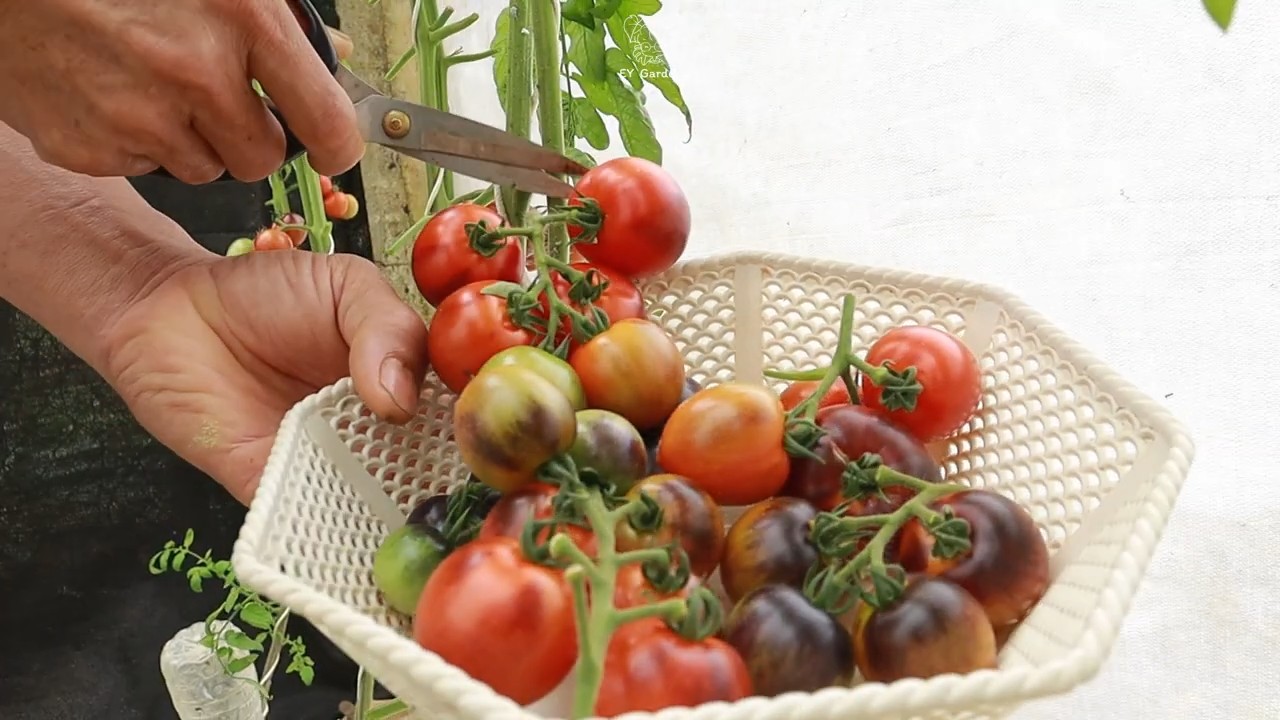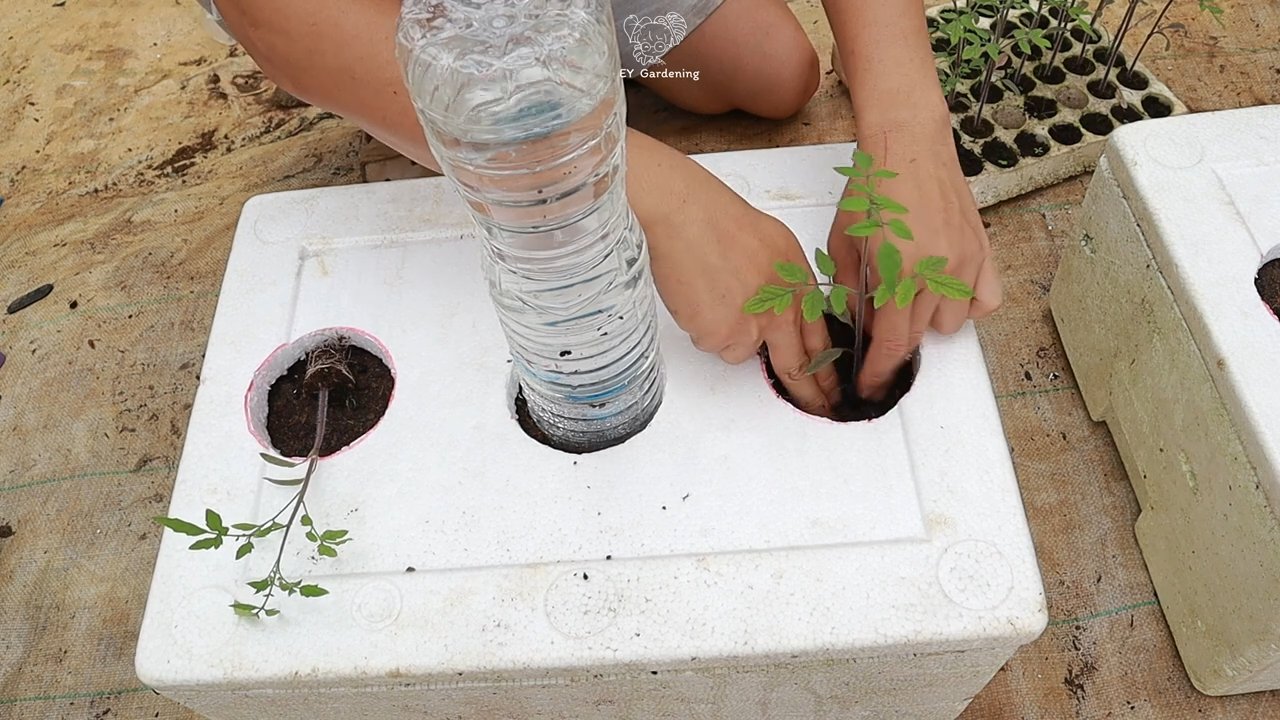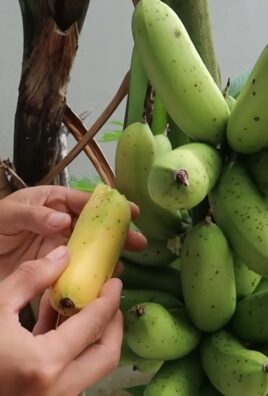Grow Black Tomatoes and unlock a world of unique flavors and stunning visual appeal right in your own backyard! Have you ever seen a tomato so dark, so mysterious, it almost looks like it belongs in a gothic fairytale? Well, get ready to cultivate your own batch of these beauties with our ultimate guide to growing black tomatoes. Forget the same old red varieties; we’re diving into the fascinating world of heirloom tomatoes and bringing a touch of the unusual to your garden.
The allure of black tomatoes isn’t just about their striking color. These tomatoes, often descendants of Russian and Eastern European varieties, boast a rich, complex flavor profile that’s both sweet and smoky. For generations, gardeners in these regions have treasured these unique fruits, passing down seeds and cultivation secrets. Now, you can join this legacy!
Why should you bother with this DIY project? Because growing your own food is incredibly rewarding, and growing black tomatoes takes that satisfaction to a whole new level. Imagine serving a salad with these dark jewels, impressing your friends and family with your gardening prowess. Plus, store-bought tomatoes often lack the depth of flavor found in homegrown varieties. With our easy-to-follow tips and tricks, even beginner gardeners can successfully grow black tomatoes and enjoy a bountiful harvest. So, grab your gardening gloves, and let’s get started on this exciting adventure!

Unlocking the Secrets to Growing Luscious Black Tomatoes: A DIY Guide
Hey there, fellow gardening enthusiasts! Ever dreamt of biting into a juicy, almost-black tomato, bursting with unique flavor? Well, dream no more! Growing black tomatoes isn’t as mysterious as it seems. I’m going to walk you through everything you need to know to cultivate these beauties in your own backyard. Get ready to impress your friends and family with your gardening prowess!
Choosing Your Black Tomato Variety
Before we get our hands dirty, let’s talk about variety. “Black tomato” isn’t just one type; it’s a category encompassing several cultivars, each with its own distinct characteristics. Here are a few popular choices:
* Black Krim: This is a classic, known for its rich, slightly salty flavor and flattened shape. It’s a great all-around tomato, perfect for slicing and enjoying fresh.
* Cherokee Purple: Despite the name, it’s more of a dusky rose-purple than true black. It has a complex, sweet-tart flavor and a meaty texture.
* Black Prince: A smaller, more compact variety, ideal for smaller gardens or containers. It has a slightly smoky flavor.
* Paul Robeson: Named after the famous singer and actor, this tomato is known for its smooth, almost creamy texture and rich, complex flavor.
* Indigo Rose: This one is truly unique! It’s a deep purple-black on the parts exposed to sunlight, fading to red where shaded. It’s also packed with anthocyanins, the same antioxidants found in blueberries.
Consider your taste preferences, growing space, and climate when making your selection. I personally love Black Krim for its reliability and classic tomato flavor, but I encourage you to experiment and find your favorite!
Getting Started: Seeds vs. Seedlings
You have two options for starting your black tomato journey: seeds or seedlings.
* Seeds: Starting from seed gives you more control over the entire process and allows you to choose from a wider variety of cultivars. However, it requires more time and effort.
* Seedlings: Buying seedlings from a nursery is a quicker and easier option, especially if you’re short on time or space. Just make sure to choose healthy, vigorous plants.
I usually start my tomatoes from seed indoors about 6-8 weeks before the last expected frost. This gives them a head start and ensures a longer growing season.
Starting from Seed: A Step-by-Step Guide
If you’re going the seed route, here’s what you’ll need:
* Tomato seeds (of your chosen variety)
* Seed starting trays or small pots
* Seed starting mix (a light, sterile potting mix)
* A spray bottle
* A heat mat (optional, but helpful)
* A grow light (optional, but highly recommended)
Now, let’s get planting!
1. Prepare your seed starting trays or pots: Fill them with seed starting mix, leaving about half an inch of space at the top. Gently tap the trays to settle the soil.
2. Sow the seeds: Make a small indentation (about ¼ inch deep) in the center of each cell or pot. Place 2-3 seeds in each indentation. This increases your chances of at least one seed germinating.
3. Cover the seeds: Gently cover the seeds with seed starting mix.
4. Water gently: Use a spray bottle to moisten the soil. Avoid overwatering, as this can lead to damping off, a fungal disease that can kill seedlings.
5. Provide warmth: Place the trays or pots on a heat mat, if using. This will help speed up germination. The ideal soil temperature for tomato seed germination is between 75-85°F (24-29°C).
6. Provide light: Place the trays or pots under a grow light, if using. Keep the light on for 14-16 hours per day. If you don’t have a grow light, place the trays or pots in a sunny window, but be aware that seedlings may become leggy (tall and spindly) if they don’t receive enough light.
7. Monitor moisture: Keep the soil consistently moist, but not soggy. Check the soil daily and water as needed.
8. Thin the seedlings: Once the seedlings have developed their first true leaves (the leaves that appear after the initial seed leaves), thin them to one seedling per cell or pot. Choose the strongest, healthiest-looking seedling and snip off the others at the soil line.
9. Harden off the seedlings: About a week before you plan to transplant the seedlings outdoors, you’ll need to “harden them off.” This means gradually exposing them to outdoor conditions to help them adjust. Start by placing the seedlings outdoors in a sheltered location for a few hours each day, gradually increasing the amount of time they spend outdoors. Protect them from direct sunlight and strong winds.
Transplanting Your Black Tomato Seedlings
Once the danger of frost has passed and the soil has warmed up, it’s time to transplant your seedlings outdoors.
1. Choose a sunny location: Black tomatoes need at least 6-8 hours of sunlight per day.
2. Prepare the soil: Amend the soil with compost or other organic matter to improve drainage and fertility. Tomatoes prefer well-drained soil with a pH of 6.0-6.8.
3. Dig the holes: Dig holes that are slightly larger than the root balls of the seedlings. Space the holes about 2-3 feet apart, depending on the variety.
4. Plant the seedlings: Gently remove the seedlings from their trays or pots. If the roots are circling the bottom of the pot, gently loosen them before planting.
5. Bury the stem: Plant the seedlings deeper than they were growing in their containers, burying the stem up to the first set of leaves. This will encourage the plant to develop more roots along the buried stem, resulting in a stronger, healthier plant.
6. Water thoroughly: Water the seedlings thoroughly after planting.
7. Add support: Install stakes, cages, or trellises to support the tomato plants as they grow. Black tomatoes can get quite large and heavy, so they’ll need support to prevent them from falling over.
Caring for Your Black Tomato Plants
Now that your black tomato plants are in the ground, it’s time to provide them with the care they need to thrive.
* Watering: Water deeply and regularly, especially during hot, dry weather. Aim to water at the base of the plant to avoid wetting the foliage, which can lead to fungal diseases.
* Fertilizing: Fertilize your tomato plants every 2-3 weeks with a balanced fertilizer. Look for a fertilizer that is specifically formulated for tomatoes.
* Mulching: Apply a layer of mulch around the base of the plants to help retain moisture, suppress weeds, and regulate soil temperature.
* Pruning: Prune your tomato plants regularly to remove suckers (the small shoots that grow between the main stem and the branches). Pruning helps to improve air circulation and prevent disease.
* Pest and disease control: Monitor your tomato plants regularly for pests and diseases. Common tomato pests include aphids, tomato hornworms, and whiteflies. Common tomato diseases include early blight, late blight, and blossom end rot. Treat any problems promptly with appropriate organic or chemical controls.
Dealing with Common Tomato Problems
Even with the best care, you might encounter some common tomato problems. Here’s how to tackle them:
* Blossom End Rot: This is caused by a calcium deficiency and results in a dark, leathery spot on the bottom of the tomato. To prevent blossom end rot, ensure your soil has adequate calcium and water consistently. You can also add calcium to the soil by incorporating crushed eggshells or bone meal.
* Early Blight: This fungal disease causes dark spots on the leaves, starting from the bottom of the plant. Remove infected leaves and apply a fungicide if necessary. Improve air circulation by pruning the plants.
* Tomato Hornworms: These large, green caterpillars can quickly defoliate a tomato plant. Handpick them off the plants or use Bacillus thuringiensis (Bt), a natural insecticide.
* Aphids: These small, sap-sucking insects can weaken tomato plants. Spray them off with a strong stream of water or use insecticidal soap.
Harvesting Your Black Tomatoes
The moment you’ve been waiting for! Black tomatoes are typically ready to harvest about 70-85 days after transplanting, depending on the variety.
* Look for color change: The color will deepen to a dusky rose, purple, or almost black, depending on the variety.
* Feel for firmness: The tomato should feel slightly soft to the touch, but not mushy.
* Check the stem: The tomato should easily detach from the stem when gently twisted.
Once harvested, store your black tomatoes at room temperature for the

Conclusion
So, there you have it! Cultivating your own black tomatoes is not just a gardening endeavor; it’s an adventure in flavor, a testament to your green thumb, and a conversation starter waiting to happen. We’ve walked you through the essential steps, from selecting the right seeds and preparing your soil to providing the necessary care and troubleshooting common issues. But why should you embark on this journey?
Firstly, the taste. Forget the bland, mass-produced tomatoes you find in supermarkets. Black tomatoes offer a complex, smoky-sweet flavor profile that will elevate your salads, sandwiches, and sauces to a whole new level. Imagine biting into a juicy, dark-hued tomato bursting with umami – a taste sensation you simply can’t replicate with conventional varieties.
Secondly, the satisfaction. There’s an unparalleled sense of accomplishment that comes from nurturing a plant from seed to harvest. Watching those tiny seedlings sprout, blossom, and eventually yield beautiful, dark fruits is incredibly rewarding. It connects you to nature, provides a therapeutic outlet, and gives you a tangible result of your efforts.
Thirdly, the uniqueness. Black tomatoes are not your everyday garden vegetable. Growing them adds a touch of exoticism and intrigue to your garden. They’re a visual delight, their deep, almost black color contrasting beautifully with the vibrant greens of your other plants. Imagine the envy of your neighbors when they see your bountiful harvest of these unusual and delicious tomatoes!
But the possibilities don’t end there. Feel free to experiment with different varieties of black tomatoes. ‘Black Krim’ is a classic choice, known for its rich flavor and large size. ‘Cherokee Purple’ offers a slightly sweeter taste and a beautiful dusky rose hue. ‘Black Prince’ is a smaller, more compact variety, perfect for container gardening.
Consider also experimenting with different growing techniques. Try companion planting with basil or marigolds to deter pests and improve the flavor of your tomatoes. Explore different types of fertilizers to see which ones yield the best results. You can even try grafting your black tomato plants onto more vigorous rootstock for increased disease resistance and productivity.
Growing black tomatoes is a journey of discovery, and we encourage you to embrace the process. Don’t be afraid to make mistakes – that’s how you learn! And most importantly, don’t forget to share your experiences with us and other gardening enthusiasts. Post photos of your black tomato harvest on social media, share your favorite recipes, and let us know what tips and tricks worked best for you.
We believe that everyone can successfully grow black tomatoes with a little patience, dedication, and the right information. So, grab your seeds, prepare your soil, and get ready to experience the joy of growing your own delicious and unique black tomatoes. Happy gardening!
Frequently Asked Questions (FAQ)
What exactly are black tomatoes, and are they really black?
Black tomatoes aren’t actually jet black. They are typically a deep reddish-purple or brownish-purple color, often with green shoulders that darken as they ripen. The “black” refers to their dark pigmentation, which is due to high levels of anthocyanins, the same antioxidants that give blueberries and other dark fruits their color. These anthocyanins not only contribute to their unique color but also offer potential health benefits. They are not genetically modified; they are heirloom or open-pollinated varieties that have been cultivated for their distinctive color and flavor.
What makes black tomatoes taste different from regular tomatoes?
The flavor of black tomatoes is often described as complex, smoky, and sweet, with a hint of earthiness. They tend to have a lower acidity than many red tomatoes, which contributes to their sweetness. The high levels of anthocyanins and other compounds also contribute to their unique flavor profile, giving them a richer, more intense taste. Many people find them to be more flavorful and satisfying than standard supermarket tomatoes.
Are black tomatoes harder to grow than other types of tomatoes?
Generally, black tomatoes are not significantly more difficult to grow than other tomato varieties. They require the same basic care: plenty of sunlight (at least 6-8 hours per day), well-drained soil, consistent watering, and regular fertilization. However, some varieties may be more susceptible to certain diseases or pests, so it’s important to choose disease-resistant varieties and monitor your plants regularly. Providing adequate support, such as staking or caging, is also crucial, especially for larger varieties.
What are some common problems I might encounter when growing black tomatoes, and how can I prevent them?
Some common problems include blossom end rot (caused by calcium deficiency), early blight (a fungal disease), and pests like aphids and tomato hornworms. To prevent blossom end rot, ensure your soil is rich in calcium and water your plants consistently. For early blight, choose disease-resistant varieties, provide good air circulation, and avoid overhead watering. To control pests, inspect your plants regularly and use organic pest control methods like insecticidal soap or neem oil. Crop rotation and companion planting can also help prevent pest and disease problems.
What are the best ways to use black tomatoes in cooking?
Black tomatoes are incredibly versatile in the kitchen. Their rich flavor makes them perfect for salads, sandwiches, sauces, and salsas. They can also be roasted, grilled, or stuffed. Their unique color adds visual appeal to any dish. Try using them in a Caprese salad with fresh mozzarella and basil, or make a smoky tomato sauce for pasta. They are also delicious simply sliced and drizzled with olive oil and balsamic vinegar.
How do I know when my black tomatoes are ripe and ready to harvest?
Determining ripeness can be a bit tricky with black tomatoes because their color doesn’t change dramatically like red tomatoes. Look for these signs: the tomato should feel slightly soft to the touch, but not mushy. The green shoulders should have darkened to a brownish-purple or reddish-purple hue. The tomato should also have a slight give when gently squeezed. The stem should easily detach from the vine when the tomato is ripe.
Can I grow black tomatoes in containers?
Yes, you can successfully grow black tomatoes in containers, especially smaller, more compact varieties like ‘Black Prince’. Choose a large container (at least 15-20 gallons) with good drainage. Use a high-quality potting mix and provide adequate support for the plant. Container-grown tomatoes may require more frequent watering and fertilization than those grown in the ground. Make sure the container receives at least 6-8 hours of sunlight per day.
Where can I buy black tomato seeds or seedlings?
You can find black tomato seeds and seedlings at many garden centers, nurseries, and online retailers. Look for reputable seed companies that specialize in heirloom and open-pollinated varieties. Some popular online sources include Baker Creek Heirloom Seeds, Seed Savers Exchange, and Johnny’s Selected Seeds. When buying seedlings, choose healthy-looking plants with strong stems and no signs of disease or pests.
How do I save seeds from my black tomatoes for next year?
Saving seeds from your black tomatoes is a great way to ensure you have a supply for future growing seasons. Choose ripe, healthy tomatoes from your best-performing plants. Squeeze the seeds and pulp into a jar and add a little water. Let the mixture ferment for a few days, stirring occasionally. This process helps remove the gelatinous coating around the seeds. After fermentation, rinse the seeds thoroughly and spread them out on a paper towel to dry completely. Store the dried seeds in an airtight container in a cool, dark place.
What are the health benefits of eating black tomatoes?
Black tomatoes are rich in antioxidants, particularly anthocyanins, which have been linked to various health benefits, including reducing the risk of heart disease, cancer, and age-related cognitive decline. They are also a good source of vitamins A and C, as well as lycopene, another powerful antioxidant. Including black tomatoes in your diet can contribute to overall health and well-being.




Leave a Comment